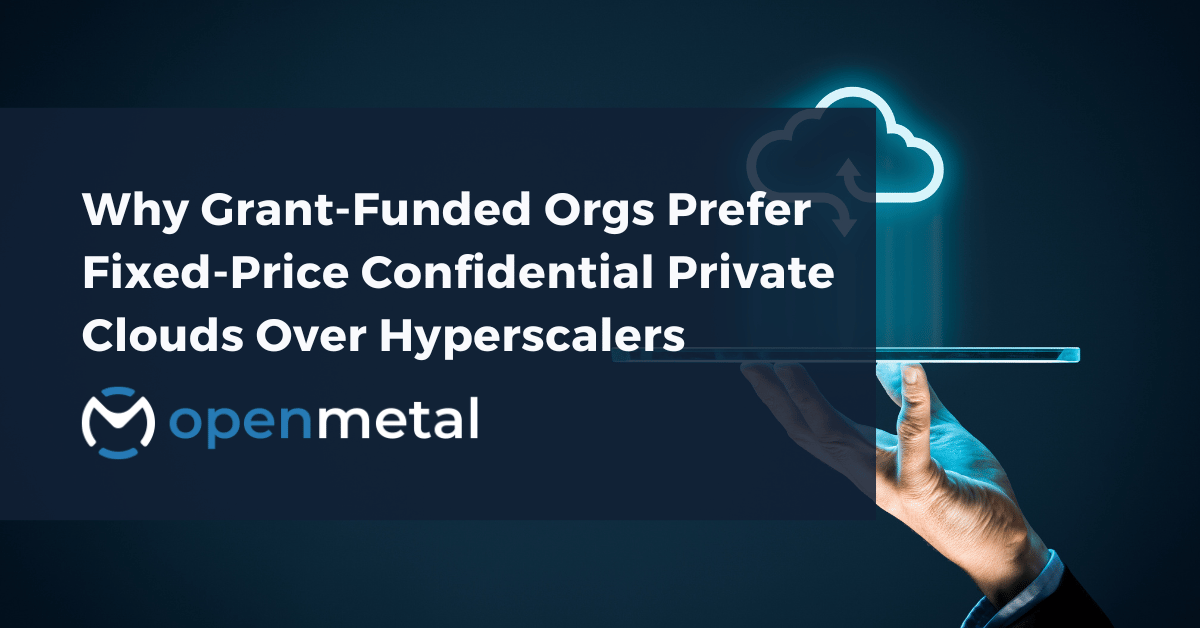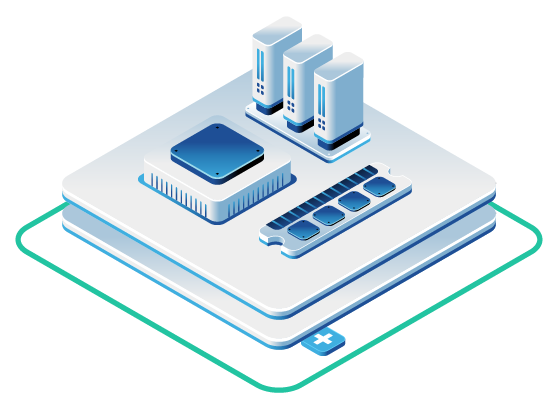
When you’re managing infrastructure for a grant-funded organization, budget predictability isn’t a preference. It’s a requirement. Universities, research institutions, and NGOs operate under strict funding allocations with defined start and end dates. Variable cloud pricing models can wreck budget compliance, create financial reporting headaches, and put entire research projects at risk when costs spike unexpectedly. Grant administrators and research IT teams are increasingly turning to fixed-price confidential private clouds instead of hyperscalers. This shift reflects practical realities: when your funding is approved for a specific dollar amount over a defined period, you need infrastructure costs that stay within those boundaries.
The Budget Problem with Hyperscaler Pricing
Public cloud pricing sounds simple until you’re three months into a grant cycle and facing egress charges you didn’t anticipate. Hyperscalers bill based on usage. Compute instances, storage capacity, data transfer, and API calls all add up separately. For teams working with large datasets or running distributed simulations, these costs can escalate quickly.
According to recent industry data, 83% of enterprises plan to move workloads off public cloud platforms1. Cost unpredictability is a major driver. One notable example comes from 37signals, which estimated nearly $7 million in savings over five years by moving off public cloud. While research organizations operate at different scales, the underlying problem is the same: variable pricing creates financial exposure that grant budgets can’t absorb.
When you submit a grant proposal, you project infrastructure costs based on anticipated workloads. If your actual spending exceeds those projections due to usage-based billing, you face budget shortfalls that can delay research, force project scope reductions, or create compliance issues with funding agencies.
Fixed-Price Infrastructure Built for Grant Compliance
OpenMetal’s hosted private cloud pricing model eliminates usage-based variables. Each deployment runs on dedicated hardware with transparent monthly costs tied to physical capacity rather than virtual resource consumption. You pay for servers, not for individual virtual machines or software licenses.
A standard private cloud cluster starts with a three-server Cloud Core running OpenStack and Ceph. Additional servers are added at fixed monthly rates. There are no separate charges for spinning up virtual machines or installing applications. Egress is billed at $375 per Gbps using 95th percentile measurement, which provides predictable bandwidth costs even for data-intensive research workflows.
This pricing structure aligns with how grant budgets work. When you know your infrastructure will cost a fixed amount each month for the duration of your project, you can plan accurately and report expenses without surprises. Financial officers can track spending against approved budgets with confidence, and principal investigators can focus on research instead of monitoring cloud bills.
Dedicated Hardware and Resource Isolation
Each OpenMetal private cloud runs on dedicated physical servers, not shared virtualized resources. Your cluster includes dual 10 Gbps private links per server. That’s 20 Gbps of unmetered internal traffic between nodes. This matters for research teams running distributed computations or moving large datasets between analysis nodes.
Network architecture includes isolated VLANs that maintain data separation even under heavy workloads. Public network connections also include dual 10 Gbps uplinks and DDoS protection up to 10 Gbps per IP address. These features support secure collaboration between distributed research teams without performance degradation during peak usage periods.
When you’re processing genomics data, running climate models, or analyzing social science datasets, you need consistent performance. Dedicated hardware means your workloads aren’t competing with other tenants for CPU cycles, memory bandwidth, or storage throughput.
Confidential Computing for Data Protection
Research projects frequently handle sensitive information. Patient health records, genomics data, personally identifiable information, or proprietary datasets subject to ethical review boards. Confidential computing provides hardware-level protections that go beyond traditional encryption.
OpenMetal’s V4 servers support Intel Trust Domain Extensions (TDX) and Software Guard Extensions (SGX). These technologies create isolated Trusted Execution Environments (TEEs) where sensitive computations occur in secure processor areas separated from the rest of the system. Data remains encrypted even while being processed, making it significantly harder for malicious parties to access information.
TEEs rely on attestation via a hardware root of trust established during the boot process. The hardware verifies that code is signed and trusted before allowing it to run in the secure enclave. This measured boot process ensures only authorized code can access protected data.
For research teams working under HIPAA, GDPR, or institutional review board requirements, confidential computing simplifies compliance. Healthcare institutions can process sensitive health records while maintaining patient privacy. Multi-institution collaborations can share encrypted datasets and run computations in TEEs that protect data confidentiality for all parties involved.
The confidential computing market reached $5.3 billion in 2023 and is expected to grow to $59.4 billion by 2028. This growth reflects increasing recognition that traditional security measures aren’t sufficient for highly regulated industries and sensitive research applications.
Fast Deployment and Scaling
Grant-funded projects often have tight timelines. Funding approval doesn’t always align neatly with project start dates, and delays in infrastructure provisioning can push back research schedules.
OpenMetal’s production-ready environments deploy in approximately 45 seconds. Scaling additional servers takes roughly 20 minutes. This fast provisioning allows research teams to spin up compute resources quickly after funding approval without waiting through lengthy procurement or setup processes.
The platform uses OpenStack with containerized services deployed through Kolla-Ansible. This open-source foundation avoids vendor lock-in, which matters when grant funding spans multiple years or when research groups need to migrate workloads between institutions.
Data Sovereignty and Regional Compliance
International research collaborations often face data sovereignty requirements. EU regulations, Canadian privacy laws, and other jurisdictions may require that certain data remain physically stored within specific geographic boundaries.
OpenMetal operates across multiple regions, allowing you to select data center locations that satisfy regulatory requirements. Research groups can ensure their environments are hosted in appropriate jurisdictions while maintaining performance parity across regions. This flexibility supports compliance without forcing technical compromises.
Engineer Support for Research Teams
Not every research institution has dedicated infrastructure staff. Principal investigators and research computing directors often manage cloud environments alongside their primary responsibilities.
OpenMetal includes engineer-assisted onboarding and dedicated Slack channels for technical support. This hands-on guidance helps teams without deep infrastructure expertise get environments configured correctly from the start. When you hit technical issues or need architecture advice, you can reach engineers who understand both the platform and the constraints of research computing.
This support model recognizes that research teams need to focus on analysis and application work rather than system administration. Having direct access to infrastructure engineers reduces troubleshooting time and helps teams make informed decisions about capacity planning and architecture design.
Why Private Cloud Makes Sense for Grant-Funded Work
The shift toward private cloud for research computing reflects broader industry trends. Recent data shows that 84% of enterprises now run both legacy and cloud-native applications in private environments1. This isn’t a retreat from modern infrastructure. It’s recognition that different workloads have different requirements.
For grant-funded organizations, those requirements center on budget predictability, data protection, and compliance accountability. Hyperscalers offer flexibility and global scale, but their pricing models introduce financial risk that grant budgets can’t accommodate. Variable costs, egress fees, and unpredictable usage patterns create budget overruns that can derail research projects.
Fixed-price confidential private clouds address these challenges directly. Transparent monthly costs enable accurate budget planning. Confidential computing features meet data protection requirements for sensitive research. Dedicated hardware provides consistent performance without resource contention. Fast deployment supports tight project timelines. And engineer support helps teams without extensive infrastructure staff.
When your research funding comes with strict spending limits and compliance requirements, your infrastructure needs to work within those constraints. That’s where fixed-price private clouds deliver value that hyperscaler models can’t match. Use the cloud deployment calculator to estimate costs for your research environment, or explore GPU server options for AI and machine learning workloads that require specialized compute resources.
[1] “8 Reasons Why Private Cloud Is Making a Comeback” Software Plaza
Read More on the OpenMetal Blog


































